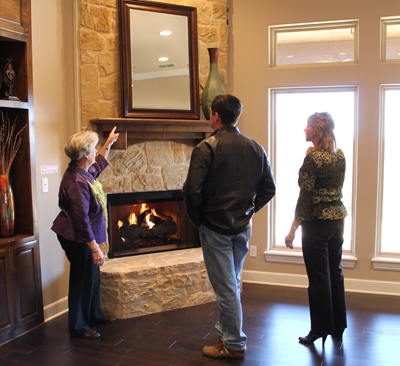 Abilene’s top real estate agents have seen it all.
Abilene’s top real estate agents have seen it all.
An avalanche of toys spilling out of children’s rooms and into living areas. Oversized furniture in small rooms. Nude artwork. Pet odors. Grimy floors and dark rooms.
Sellers may not notice these problems or think potential buyers won’t care. But real estate agents say they had better think again! Clutter, lack of cleanliness and dark rooms can dull a buyer’s interest faster than the speed of light.
“Nothing kills a showing like a ceiling fan on with one light burning and it’s 25 watts,” said Kay Spiva, an agent with Stovall Realtors.
Spiva, an agent for 17 years, tells her home sellers to focus on lighting, windows and lots of good old fashioned scrubbing.
“You would be amazed at the houses we go in and they have it on the market,” she said, her eyes widening in amazement.
Pam Yungblut, an agent with Senter Realtors, said cleanliness is a must for sellers. And people shouldn’t take shortcuts to make a home appear clean.
“I do think a house that smells clean smells better than a ‘plug-in’ air freshener,” she said.
Spiva added that it’s not just surfaces you can see at eye-level that need to be cleaned and in good condition. Look up, because buyers will, too. Light fixtures and ceiling fans need to be clean and all of the lights need to be working and at a strong wattage. Wash windows and open curtains.
“You need bright lights to really show off a house,” Yungblut said.
Price, condition and location are the top three reasons why a house does or does not sell, said Yungblut, a real estate agent for 26 years.
And while there’s not much a homeowner can do about a home’s location, agents said there’s plenty of other things they can do to get that sold sign up quickly:
Realtor vs. sell it yourself
Abilene agents said the fastest way to sell a house and get the most money is to hire a Realtor and not try to sell it yourself.
Get a good agent you trust who will walk through your house and honestly tell you what needs to be done, Spiva said. She said real estate law is complex, and it’s best to hire an expert in that area.
Agents will also market your home, stage open houses and have access to recently sold home prices and other data in the Multiple Listing Service (MLS) that can help price a home competitively.
The price is right
When pricing a listing, Yungblut looks at homes sold in the last six months in the area. Typically, there is a high and low amount depending on the location and condition. She also looks at what houses are currently for sale –the competition.
Seller motivation also plays a factor in pricing a home. Some people want to get out fast and others are not in a hurry. Divorce, new jobs, retirement, new babies and other circumstances all play a role in how badly people want to move.
Spiva said look at what’s sold (which the lender will use) and what the competition is in the area. If there are five homes for sale at $150,000 that are of similar size, age and condition, don’t overprice your listing at $160,000. Be responsive to the market, Spiva added.
The majority of Abilene homes sold in 2011 were in the $140,000 to $159,999 price range, according to the 2012 market report put out by the Real Estate Center at Texas A&M University.
Condition counts
Yungblut said when she tours a house before it goes on the market, she looks at what needs repaired, decluttering, updates and landscaping.
She doesn’t want sellers to spend a lot of money on repairs, depending on the situation. In some cases, homeowners can sell a house at a reduced price because of its condition and come out further ahead than if they had made all of repairs needed. Yungblut said she tries to get sellers out at the highest price for the lowest amount of investment possible.
Do repairs before you put a home on the market. It turns off potential buyers to walk through a house and see sticky notes everywhere announcing plans to paint this or replace that.
“If it’s going to be done, then get it done and move on,” Spiva said.
In addition to regular cleaning, putting a home on the market means tackling deep cleaning projects. Put the oven on the cleaning cycle until it’s sparking. Replace the air conditioner filter with eight months of cat fur stuck in it.
Sellers need to put aside their personal attachment to a home and its contents and look at their house as a buyer would.
Spiva remembers a couple who had owned a home for many years but no longer lived in it and were renting it. They wisely replaced the carpet and painted the interior.
But they were oblivious to how the home appeared on the outside.
“I said you have a great house, but you can’t see it,” Spiva said.
The trees and bushes were so overgrown, they were blocking the front of the house.
The homeowner laughed and said he saw what she meant. He spent $300 or $400 trimming the overgrown foliage. When it was done, the home was unrecognizable it looked so good. It sold in 17 days.
Other home conditions that may affect the price and selling time are heavy decor and bright wall colors.
Sellers need to have neutral colors throughout their home, such as creams and warm tones. Taupes and grays are not always well received, Spiva said. Red is okay if it’s on an accent wall or in the dining room.
As for decor, neutral is best. Spiva said one homeowner decorated the house in a Southwest theme. It sat on the market for six months. By the time she got the listing, Spiva said, the home was vacant and neutral–the Southwest decor was gone. She posted new photos on MLS and the home sold in four weeks.
Some agents hire home stagers to arrange houses to look like model homes. Yungblut said sellers can stage a home themselves by moving things around to improve room flow, decluttering and adding warmth.
“I love to see lamps, rugs and curtains,” she said. “They really warm up a home.”
Killer clutter
Less is more when it comes to furniture and personal belongings, say agents. They want potential buyers to be able to picture themselves in a spacious home.
One or two personal pictures displayed is plenty, said Yungblut.
And too often she walks into homes with toys overflowing everywhere. She suggests picking three favorite toys and packing up the rest.
Removing clutter is essential to getting good photos of a property when it’s first listed. Those will go onto websites that buyers will probably see before they are willing to set foot in the door.
“Photos are our first opportunity of a good first impression,” Spiva said.
And agents need to be able to take lots of pictures. Only five or six pictures doesn’t cut it – it leaves potential buyers with the idea that sellers are hiding something that’s wrong with the home.
Spiva remembers one seller with two large couches in the living room. When people walked in the front door, they were faced with the back of a couch and a crowded room. Spiva wanted to improve the room flow and asked the homeowner to move one sofa to the garage and re-position the other one.
When she returned the next day, Spiva said she found the homeowner had fulfilled her requests–with an unexpected benefit. He liked the new furniture arrangement better! He added that he wished he had laid out his living room that way from the beginning.
Spiva said it helps if homeowners are open to suggestions their real estate agents make for improvements. She tries to be sensitive when asking homeowners to make changes, including removing personal photos and anything distracting. No nude photos of anyone over 12 months of age, Spiva joked.
“It’s always hard. You don’t want to criticize,” she said. “But to sell, they may have to modify their lifestyle while the home is on the market.”
The easiest way to remove clutter is to box it up and store it in the garage. Agents said a garage full of boxes is acceptable and will not bother most buyers. Renting a storage unit for the overflow is also a solution.
Pet problems
Because many people are sensitive to pet odors, real estate agents recommend home sellers try to remove as much evidence as possible that a pet even lives there.
They may even suggest animals move to a temporary home. And do not include pets in any photos posted on real estate websites, Spiva said. She said the photos for one home on the market had the family’s pooch posing in every single picture!
Among the problems pets pose when selling a property: odors; stains; damaged landscaping, furniture, floors, walls, cabinets and doors; and scaring buyers.
Several years ago, one buyer in the Wylie school district was so fearful of the homeowners’ cats she would not enter the home during the inspection.
Agents recommend either removing pets from the property when potential buyers are on the premises or confining them in a cage, fence or garage. Spiva suggested cleaning cat litter boxes daily and keeping them out of sight – but not in places buyers will be repulsed by, such as a clothes closet in the bedroom or a bathroom.
She added that dog owners need to pick up the poop in their yard. Spiva said one backyard was so bad, her clients could not walk outside.
Occupied homes
Selling property occupied by a tenant is especially difficult, Spiva said.
Renters do not have a vested interest in a property selling. They may not clean up or declutter the way a homeowner would while a house is for sale. Worse, they may not want the home to sell and find ways to steer potential buyers off course.
Spiva said sometimes, the best thing an owner can do is wait until the property is vacant to put it on the market. Once the renter’s belongings are removed, repairs and remodeling can be done to get the home ready to sell.
A few last tips
Yungblut said savvy sellers will make sure they have their home survey available, disclose any problems when they list the property and mention any upgrades such as a new roof. She said sellers should leave copies of those lists at the house so potential buyers walking through can pick those up.
She added that green yards–even in dry, dusty West Central Texas–are still a selling point and even expected by some buyers. Yungblut tells sellers to buy fertilizer with high nitrogen levels to green up their yards. She said hand water foliage if necessary to keep it healthy and green. Also sweep porches, mow yards, trim bushes and wash windows.
Sellers should not be at home when the house is being shown. Give potential buyers privacy.
Don’t leave candles burning when you are not at home, Yungblut said.
She also tells clients to keep valuable jewelry, guns and cash out of sight, even in closets. She hasn’t had any issues with theft but she said it’s best not to tempt people.
Swimming pools should be clean and working, if buyers are expecting value out of it.
Get a home inspection before the house goes on the market, suggests Jerry Mash, owner/broker of Coldwell Banker Panian & Mash. Buyers aren’t the only ones who can get an inspection. Sellers can, too. The added expense can result in a big pay off if repairs are made ahead of time, giving buyers less reason to submit a low offer.
Mash said he knows of one woman who always gets a home inspection before her house hits the market. She makes any needed repairs, cleans the carpets, adds fresh paint and sometimes hires a home stager. Her homes sell within days at a premium price. He knows this firsthand. “I know because I’m married to her,” he said with a smile.































Leave a Reply